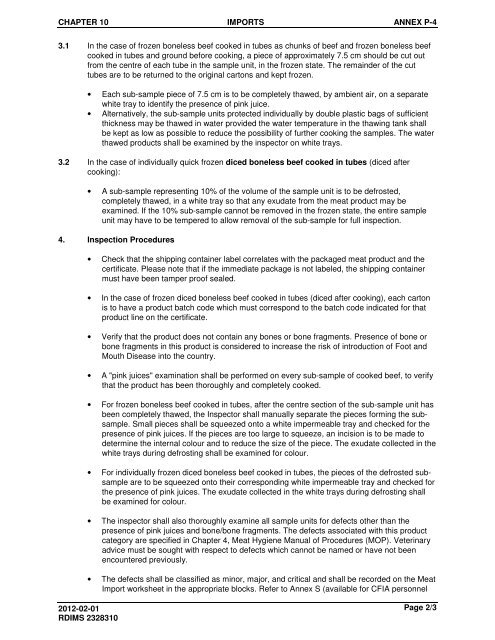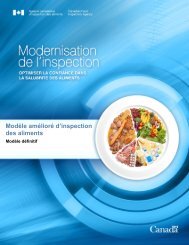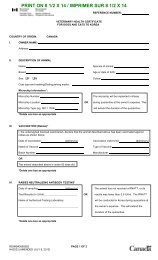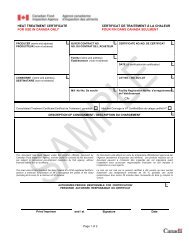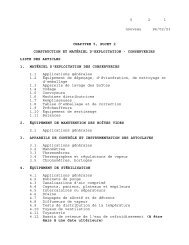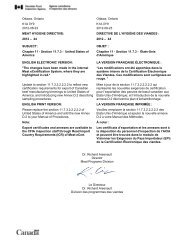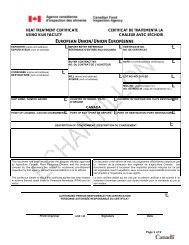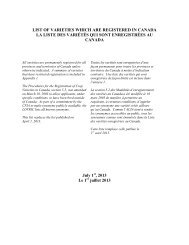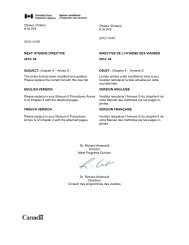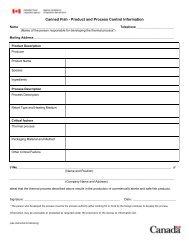PDF (342 kb ) - Agence canadienne d'inspection des aliments
PDF (342 kb ) - Agence canadienne d'inspection des aliments
PDF (342 kb ) - Agence canadienne d'inspection des aliments
You also want an ePaper? Increase the reach of your titles
YUMPU automatically turns print PDFs into web optimized ePapers that Google loves.
CHAPTER 10 IMPORTS ANNEX P-43.1 In the case of frozen boneless beef cooked in tubes as chunks of beef and frozen boneless beefcooked in tubes and ground before cooking, a piece of approximately 7.5 cm should be cut outfrom the centre of each tube in the sample unit, in the frozen state. The remainder of the cuttubes are to be returned to the original cartons and kept frozen.• Each sub-sample piece of 7.5 cm is to be completely thawed, by ambient air, on a separatewhite tray to identify the presence of pink juice.• Alternatively, the sub-sample units protected individually by double plastic bags of sufficientthickness may be thawed in water provided the water temperature in the thawing tank shallbe kept as low as possible to reduce the possibility of further cooking the samples. The waterthawed products shall be examined by the inspector on white trays.3.2 In the case of individually quick frozen diced boneless beef cooked in tubes (diced aftercooking):• A sub-sample representing 10% of the volume of the sample unit is to be defrosted,completely thawed, in a white tray so that any exudate from the meat product may beexamined. If the 10% sub-sample cannot be removed in the frozen state, the entire sampleunit may have to be tempered to allow removal of the sub-sample for full inspection.4. Inspection Procedures• Check that the shipping container label correlates with the packaged meat product and thecertificate. Please note that if the immediate package is not labeled, the shipping containermust have been tamper proof sealed.• In the case of frozen diced boneless beef cooked in tubes (diced after cooking), each cartonis to have a product batch code which must correspond to the batch code indicated for thatproduct line on the certificate.• Verify that the product does not contain any bones or bone fragments. Presence of bone orbone fragments in this product is considered to increase the risk of introduction of Foot andMouth Disease into the country.• A "pink juices" examination shall be performed on every sub-sample of cooked beef, to verifythat the product has been thoroughly and completely cooked.• For frozen boneless beef cooked in tubes, after the centre section of the sub-sample unit hasbeen completely thawed, the Inspector shall manually separate the pieces forming the subsample.Small pieces shall be squeezed onto a white impermeable tray and checked for thepresence of pink juices. If the pieces are too large to squeeze, an incision is to be made todetermine the internal colour and to reduce the size of the piece. The exudate collected in thewhite trays during defrosting shall be examined for colour.• For individually frozen diced boneless beef cooked in tubes, the pieces of the defrosted subsampleare to be squeezed onto their corresponding white impermeable tray and checked forthe presence of pink juices. The exudate collected in the white trays during defrosting shallbe examined for colour.• The inspector shall also thoroughly examine all sample units for defects other than thepresence of pink juices and bone/bone fragments. The defects associated with this productcategory are specified in Chapter 4, Meat Hygiene Manual of Procedures (MOP). Veterinaryadvice must be sought with respect to defects which cannot be named or have not beenencountered previously.• The defects shall be classified as minor, major, and critical and shall be recorded on the MeatImport worksheet in the appropriate blocks. Refer to Annex S (available for CFIA personnel2012-02-01RDIMS 2328310Page 2/3


